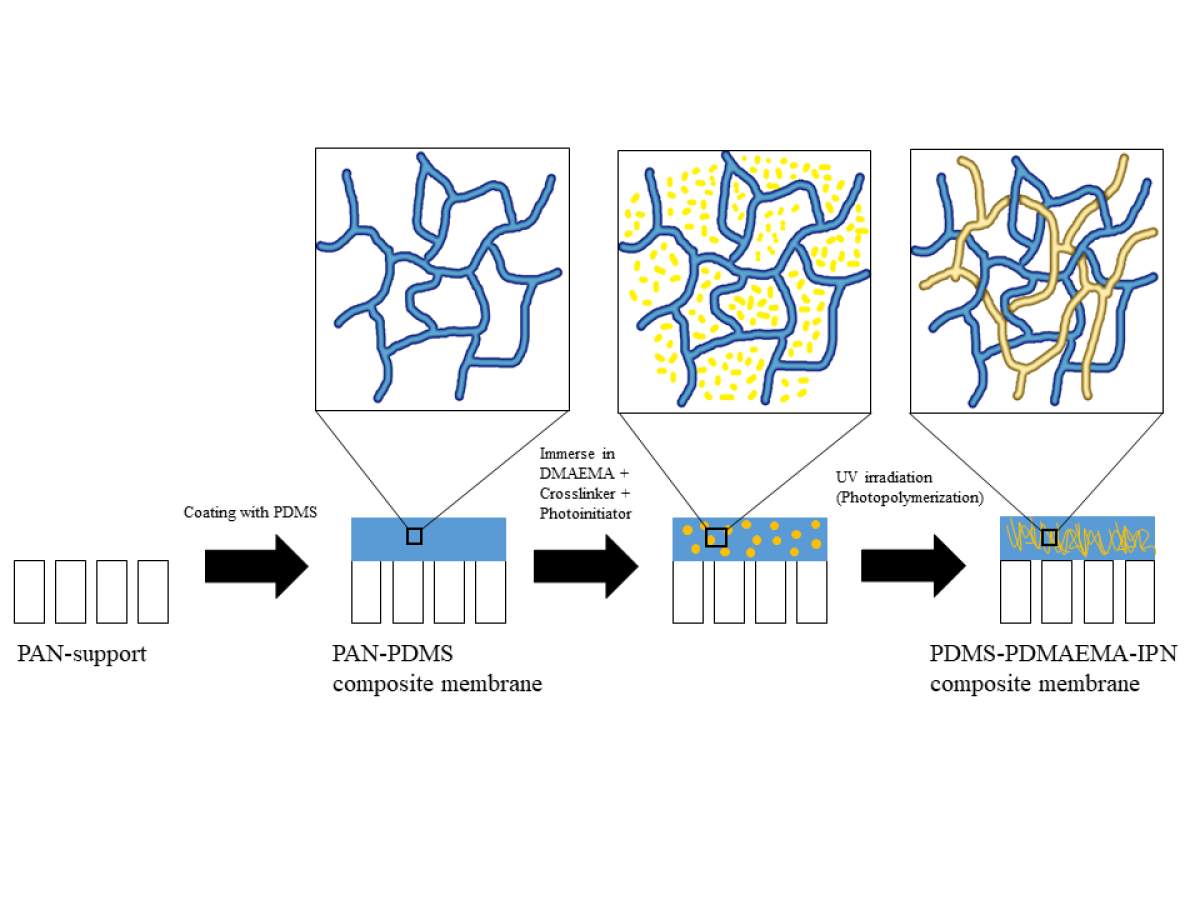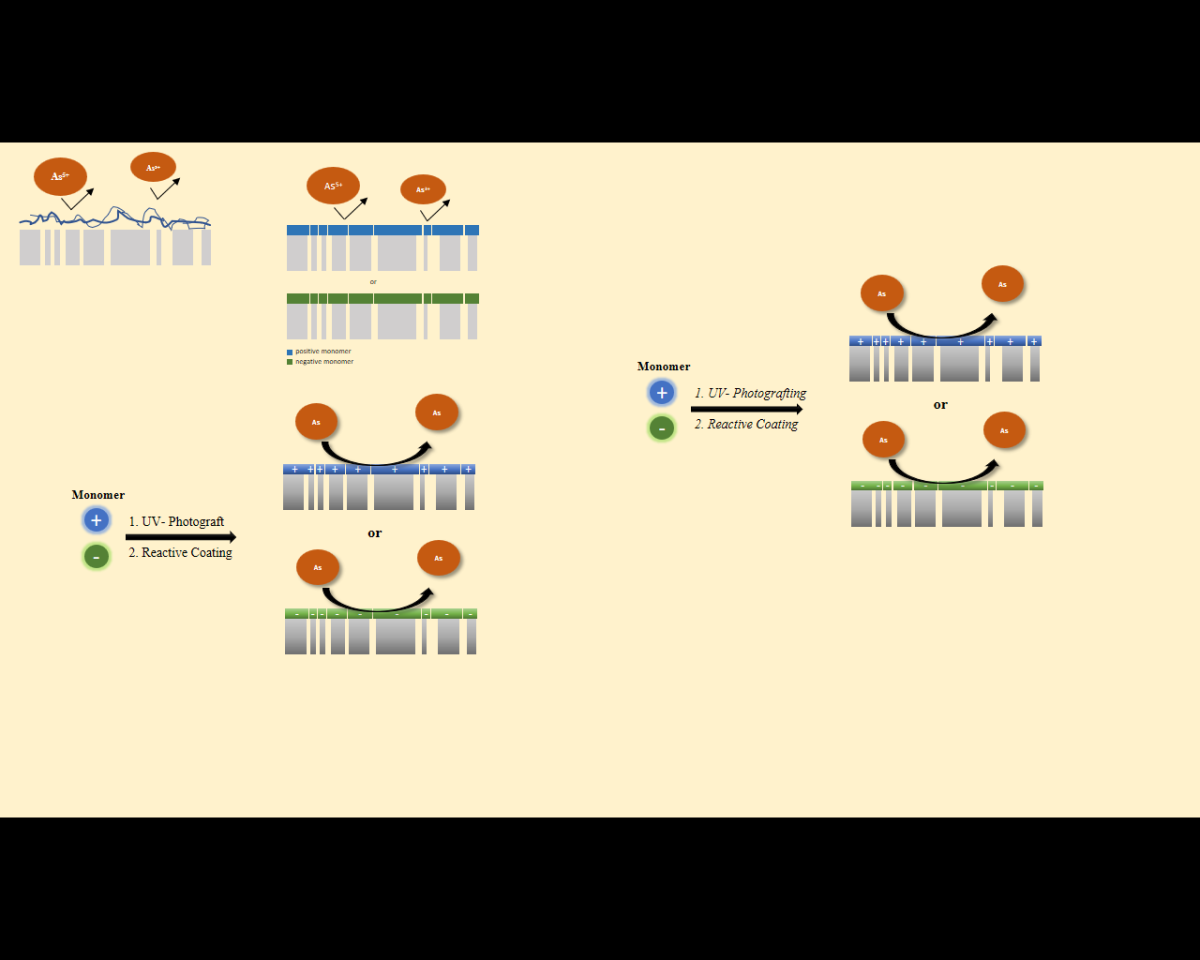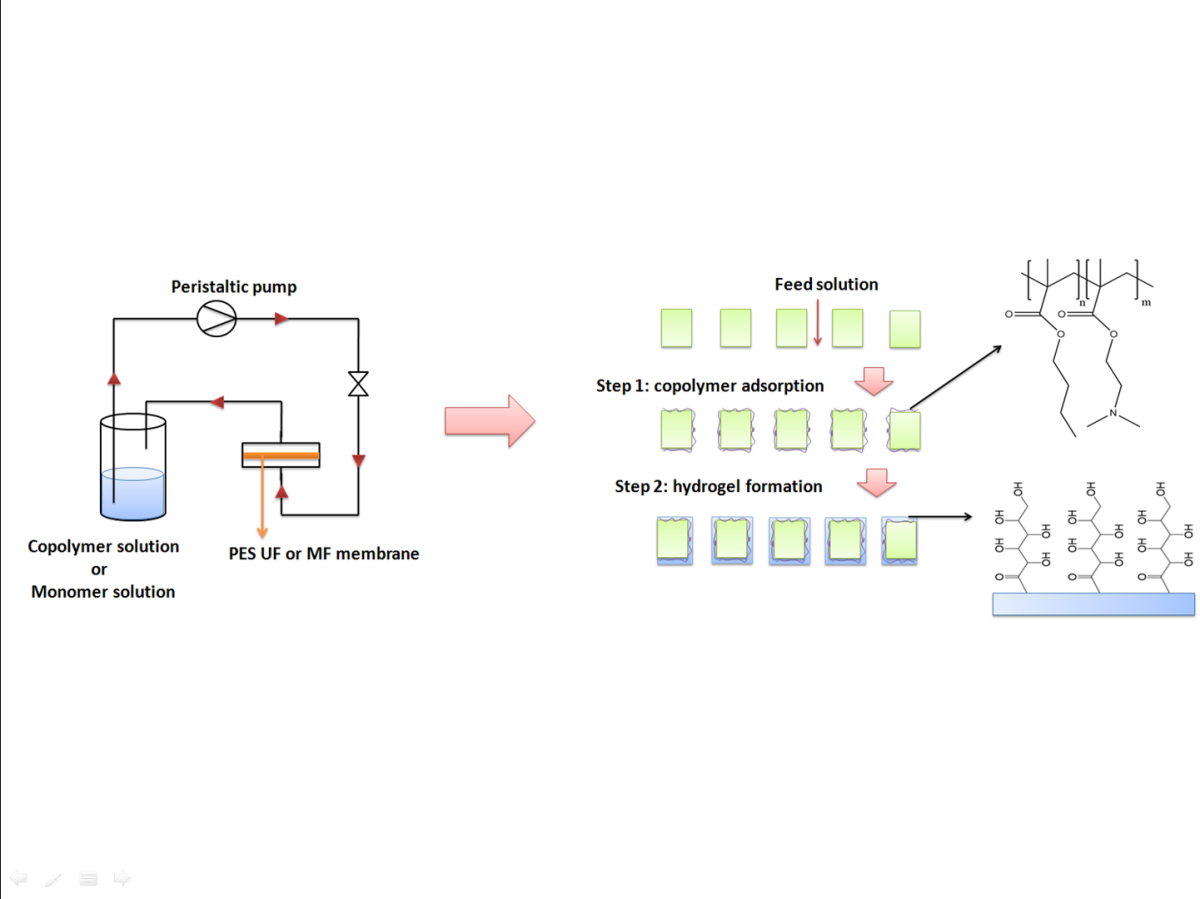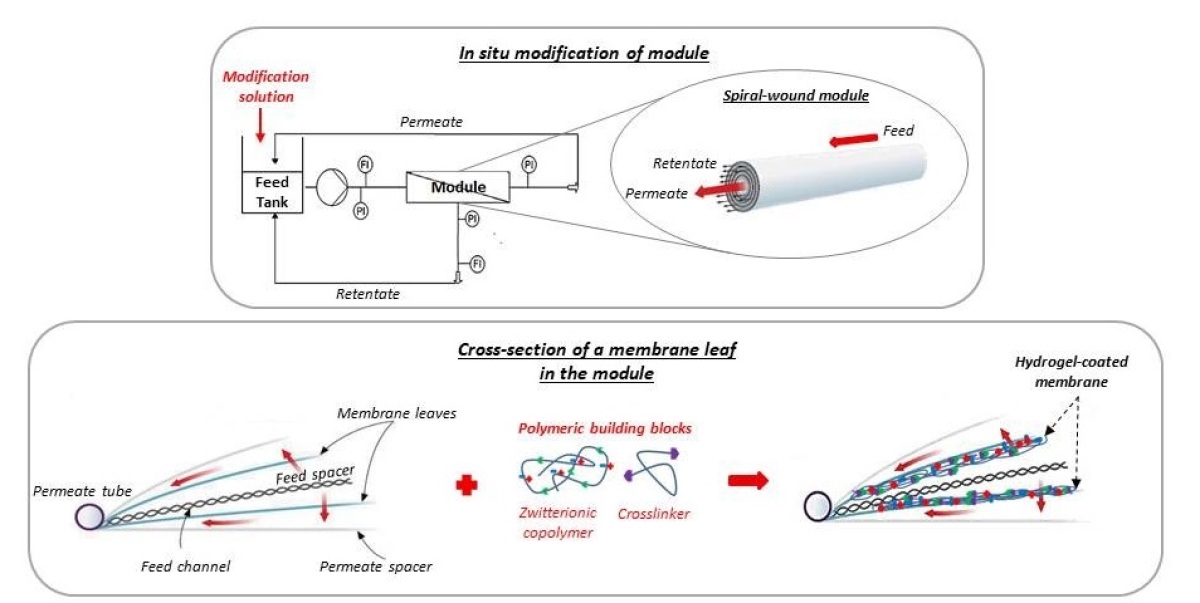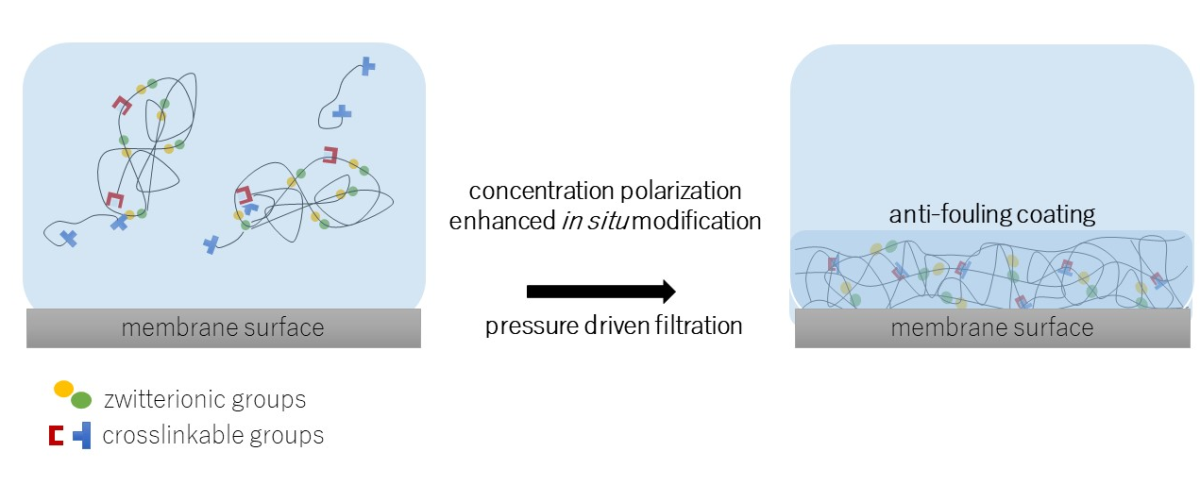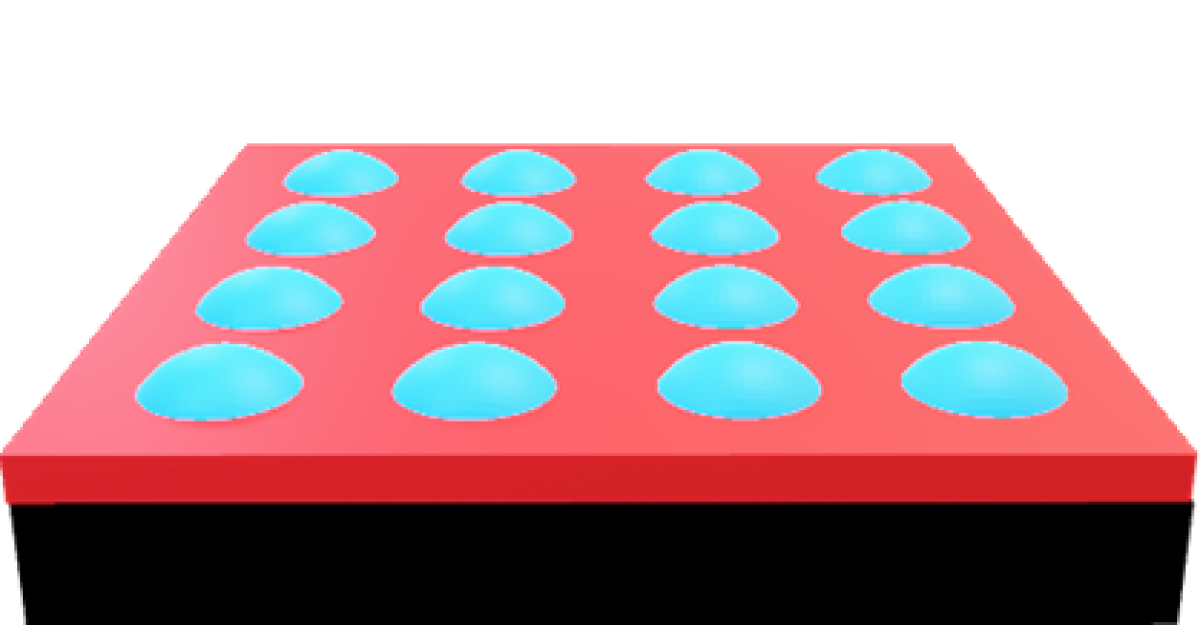Separation membranes: surface functionalization
Content
- Amphiphilic copolymer thin-film composite membranes for nanofiltration and pervaporation
- Arsenic Removal in Water Treatment with Tailored Nanofiltration Membrane
- Boron-selective membranes by surface functionalization with affinity hydrogel
- Development and evaluation of an antifouling coating for reverse osmosis membranes which can be applied in modules
- In situ crosslinkable anti-fouling hydrogel coatings for filtration membranes
- Star polymers as functional building blocks for nanofiltration membranes
- Toward charge mosaic membranes for nanofiltration with unconventional ion selectivity
Amphiphilic copolymer thin-film composite membranes for nanofiltration and pervaporation
In chemical and pharmaceutical industry, the recovery or exchange of organic solvents is increasingly important to create more sustainable processes. Special properties, in particular stability under processes conditions, are necessary for the use in organic solvent nanofiltration or pervaporation. One established material is polydimethylsiloxane (PDMS). Amphiphilic thin-film composite membranes show promising, potentially tunable separation performance due to a barrier structure with microphase-segregated morphologies but are only rarely studied until now.
Our approach is to explore interpenetrating network (IPN) membranes based on PDMS and poly(2-dimethylaminoethyl)methacrylate (PDMAEMA) in order to obtain thin-film composite membranes with a tunable barrier structure. Therefore, a thin PDMS layer is coated on top of a porous polyacrylonitrile (PAN) support. In a second step, the PDMS membrane is placed in a solution of DMAEMA monomer, a cross-linker monomer and a photo-initiator, followed by cross-linking copolymerization activated via UV irradiation. To further promote microphase separation in the IPN, the PDMAEMA can be functionalized to a polyzwitterion via sulfobetainization using propane-1,3-sultone in a third step.[1] One important factor is the PDMS itself, which can be influenced by the crosslinker fraction and the curing temperature during preparation. The second important aspect is the formation and separation performance of the IPN. The feasibility has been demonstrated using a commercial PDMS composite membrane (Pervap 4060, DeltaMem AG) which had been converted into a PDMS-PDMAEMA-IPN composite membrane. Nanofiltration data for different organic solvents indicate that the formation of the amphiphilic IPN leads to changed barrier properties because the permeance of non-polar hexane is largely reduced while that of polar isopropanol is increased. Ongoing work is devoted to variations of the PDMS layer and IPN structure and the evaluation of the novel membranes with respect to permeance and selectivity in separation of mixtures by nanofiltration or pervaporation.
References:
[1] A. Dundua, S. Franzka, M. Ulbricht, Macromolecular Rapid Communications, 2016, 37, 2030-2036.
Contact: Marcel Matthias, M.Sc.
Arsenic Removal in Water Treatment with Tailored Nanofiltration Membrane
The presence of arsenic (As) in groundwater is relatively normal, though the excessive and long-term intake of inorganic As with concentration over 0,05 mg/L leads to arsenicosis for humans, causing, e.g. skin problems, disease of blood vessels and reproductive disorders. For As removal in the water treatment, nanofiltration (NF) membranes have already been used with one or more pre-treatments. In order to reach higher efficiency with respect to the balance between selectivity, capacity and simplicity of As removal using membrane filtration, a post-functionalization of the selective layer of ultrafiltration UF membrane with negative and positive charged monomers will be implemented. Thus, the chemical use for membrane cleaning and energy consumption of the overall membrane process should also be reduced.
Bernstein et al. (2012) had used direct UV-photografting of polyethersulfone (PES) UF membranes with vinyl sulfonic acid (VSA) as negatively charged monomer and N,N’-methylenbisacrylamide (MBAA) as the crosslinker monomer to obtained a selective hydrogel layer with NF properties [1]. Previously, Ulbricht et al., (1998) had succesfully used 2-trimethylammonium-ethyl methacrylate chloride (AmEMA) as positively charged monomer by a similar method and with similar effect, i.e. separation properties of polyacrylonitrile UF membrane changed to NF capability [3]. An alternative, potentially more versatile modification is reactive coating process, where the free radical polymerisation is initiated with a surface-adsorbed macro-initiator (Quilitzsch et al. (2016)) [2].
In this work, the base UF membranes are made of PES and polyvinylidenefluoride (PVDF). The above-mentioned methods are adapted to the different base membranes and charged monomer systems and modified membranes are firstly characterised with respect to degree of grafting (DG) as well as the relation between permeability and solute rejection. If the results are similar or better than the benchmarks, the novel membranes will be further characterized with respect to the details of their barrier structure and separation performance for As removal from different waters will be evaluated systematically.
References
[1] Bernstein, R., Antón, E. & Ulbricht, M., UV-Photo Graft Functionalization of Polyethersulfone Membrane with Strong Polyelectrolyte Hydrogel and Its Application for Nanofiltration, 2012, ACS Applied Materials & Interfaces, 4(7): 3438–3446.
[2] Quilitzsch, M., Osmond, R., Krug, M., Heijnen, M. & Ulbricht, M., Macro-initiator mediated surface selective functionalization of ultrafiltration membranes with anti-fouling hydrogel layers applicable to ready-to-use capillary membrane modules, 2016, Journal of Membrane Science, 518: 328–337.
[3] Ulbricht, M., Richau, K. & Kamusewitz, H., Chemically and morphologically defined ultrafiltration membrane surfaces prepared by heterogeneous photo-initiated graft polymerization, 1998, Colloids and Surfaces A: Physicochemical and Engineering Aspects, 138: 353–366.
Funding: Supported by PhD Scholarship from Avicenna-Studienwerk e.V.
Contact: Aisha Sean Jurnalis, M.Sc.
Boron-selective membranes by surface functionalization with affinity hydrogel
State-of-the-art reverse osmosis membranes for desalination have limited competence to efficiently remove boron. The boron concentration in seawater is around 5 mg/L while the limit for irrigation is 0.5 mg/L [1]. One promising approach for boron removal is to integrate membrane-based separation with selective adsorption of boron. Hydrogel-coated filtration membrane is one of the attractive solutions leading to maximum boron binding capacity at minimized loss of permeability. An ideal membrane modification protocol should be a continuous procedure, tunable, environmentally friendly and ready to upscale. In this project, a newly developed surface modification can be implemented on microfiltration (MF) or ultrafiltration (MF) membrane/modules depending on the projected applications. The pore surface of commercial polyethersulfone micro- and ultrafiltration membranes can be modified with a hydrogel layer which contains polyol groups for selective boron binding. The modification protocol includes two steps: 1) adsorption of a copolymer which contains tertiary amine groups as co-initiator for free radical generation [2]; 2) surface-initiated grafting of a hydrogel layer by using a monomer solution comprising a polyol monomer, a cross-linker monomer and a redox initiator. The entire modification process is performed with recirculation of the solutions under different conditions. The influences of flow rate, modification time, membrane pore size and composition of the monomer solution are investigated. Boron binding is evaluated by boron adsorption isotherms and kinetics, as well as in break-through experiments. The regeneration of this membrane absorber is also studied. Under controlling the modification parameters, the boron binding capacity and permeability of final modified membranes is tunable in order to meet different projected applications.
References
[1] E. Guler, C. Kaya, N. Kabay, M. Arda, Desalination, 2015, 356, 85-93.
[2] M. Quilitzsch, R. Osmond, M. Krug, M. Heijnen, M. Ulbricht, Journal of Membrane Science, 2016, 518, 328-337.
Funding: The work is supported by a Ph.D. scholarship of the Chinese Scholarship Council (CSC)
Contact: Qirong Ke, M.Sc.
Development and evaluation of an antifouling coating for reverse osmosis membranes which can be applied in modules
Cooling water is used for process and product cooling in many industries; an example is steel production and processing with a water requirement of 2.3 billion m3/a for cooling circuits. The water cycles as well as the cooling water matrix are very complex due to process contamination and the addition of conditioning chemicals. Furthermore, salting appears to be a big problem because of the recirculation in the cooling circuits and the evaporation which requires up to 200 m3/h of blowdown water for a typical steel plant. Reverse osmosis (RO) provides a good alternative for processing water from cooling circuits. However, since RO membranes are able to retain all relevant substances including monovalent ions, they are particularly susceptible to all types of fouling. Thus, the required performance cannot be achieved without feed pre-treatment and/or the membranes should be made more resistant to fouling.
In this project desalination processes based on RO are developed by critically evaluating the separation performance of established membranes, by developing an in situ modification for RO flat-sheet membranes and transferring this to spiral-wound RO modules and by implementing such modules in a cooling circuit for the steel industry. As a first step, interactions between commercially proven membranes and critical components of the cooling water are investigated in dead-end batch mode with focus on membrane fouling. This provides the basis for the design of a novel antifouling hydrogel coating for flat-sheet membranes via concentration polarization-enhanced [1] cross-linking reaction of tailored polymeric building blocks [2]. Conditions which are suited for a protective polyzwitterionic hydrogel coating modification are identified in dead-end filtration experiments. Antifouling properties at minimized loss of initial membrane permeability can be obtained. In a second step, the novel antifouling coating is transferred to spiral-wound RO membrane modules. In the last step, a detailed investigation of the fouling behavior and long-term stability of hydrogel-coated modules which are implemented in a cooling circuit is done in pilot scale tests.
References:
[1] R. Bernstein, S. Belfer, V. Freger, Langmuir, 2010, 26, 3168
[2] P. May, Concentration polarization enabled hydrogel coating of desalination membranes using zwitterionic polymeric building blocks, Dissertation, Universität Duisburg-Essen, 2020
Funding: This work is part of the cooperative project “WEISS” which is funded by the Bundesministerium für Bildung und Forschung (BMBF) within the funding initiative “WavE”; reference number: 02WAV1411.
Contact: Soraya Laghmari, M.Sc.
In situ crosslinkable anti-fouling hydrogel coatings for filtration membranes
Although membrane-based separations became tailor-made for several applications in recent years, they still suffer from limited separation performance, i.e. the relation between permeability and selectivity, and are also highly affected by fouling processes. Fouling can be generally divided into three categories, namely biofouling, colloidal fouling (especially by natural organic matter) and inorganic fouling (scaling). Besides operational conditions as well as feed water and foulant characteristics, membrane properties are a crucial factor for fouling mechanisms. Despite that many membrane functionalizations show improved anti-fouling behavior, their application is still limited to lab-scale or implementation during membrane fabrication.
This project is focusing on surface-selective, reactive anti-fouling hydrogel coatings which can be applied on demand in situ to filtration membranes in modules [1,2]. To obtain such protective layer systems, it is promising to establish zwitterionic copolymers as building blocks which can be crosslinked to hydrogels on surfaces by using a second functionality. Zwitterionic segments, e.g. carboxy- or sulfobetaines, can inhibit nonspecific adsorption, what is attributed to a strongly bound hydration water shell. The second functionality of the building blocks should, in combination with an added crosslinker or initiator system having complementary reactivity, enable chemical crosslinking [3]. Such a system will only form a polyzwitterionic hydrogel above a critical concentration and thus concentration polarization can be utilized to form the hydrogel only on the membrane surface. According to the film model, filtration through a membrane will lead to a concentration gradient of retained substances, resulting from a balance of convective and diffusive mass transport. Thus applying a filtration with crosslinkable building blocks which are rejected by the membrane will increase their concentration at the membrane surface. For a controlled modification feed concentration as well as flux can be adjusted to obtain the necessary gelation conditions. Additionally, to guarantee tight grafting of these hydrogel layers, one can take advantage of the chemical properties of the membrane to be coated. For example, polyamide nanofiltration membranes often offer a negatively charged surface, which can be covered with a cationic and cross-linkable macromolecular surface linker. Various building polymeric blocks and surface linkers for coating systems are synthesized, coating preparation conditions are established, and the coating-protected membranes are evaluated with respect to permeability, solute rejection and resistance to fouling.
References
[1] J. Lei, M. Ulbricht, Journal Membrane Science, 2014, 455, 207
[2] M. Quilitzsch, R. Osmond, M. Krug, M. Heijnen, M. Ulbricht, Journal Membrane Science, 2016, 518, 328
[3] K. Daumann, P. May, J. Brückerhoff, M. Ulbricht, Reactive and Functional Polymers, 2018, 131, 251
Contact: Patrick May
Star polymers as functional building blocks for nanofiltration membranes
Thin film composite (TFC) membranes play an important role in many separation processes, e.g. water desalination or gas separation. Due to this versatile applicability, very good separation performance and relatively low costs and energy input, interest in TFC membranes with separation properties specifically tailored to certain separation processes is growing. In order to obtain such membranes with high permeability, permselectivity and fouling resistance, already established membrane systems can be combined with novel building blocks. A class of promising building blocks are star polymers. These have a compact, globular structure with a high density of functional groups [1].
In this work star polymers are synthesized using cyclodextrins as core by controlled atom transfer radical polymerization (ATRP). Subsequently, the star polymers are embedded in TFC polyamide membranes by interfacial polymerization [2,3]. Polyamide membranes are commonly used in nanofiltration or reverse osmosis processes. By functionalizing them with star polymers, the membranes’ permeability is expected to increase significantly while the typical selectivity is expected to change, because the incorporated building blocks act as transport domains in the ultrathin separation layer. Of particular interest are membranes which contain building blocks of two or more different types. Star polymers of variable size in the range of 10 nm and low polydispersity, containing anion exchange groups, could be synthesized. Such star polymers were integrated in polyamide TFC membranes. Functionalization with such star polymer shifts the membranes‘ surface charge from negative to positive values, which indicates their successful integration in the separation layer. Modified polyamide TFC membranes on anisotropic support with positively charged star polymer show much higher permeance at same NaCl or sucrose rejection compared to analogous unmodified membranes, but much lower Na2SO4 rejection. All these findings indicate permeation through star polymer domains in the barrier layer.
Reference:
[1] Ren, J. M., McKenzie, T. G. et al, Star Polymers, Chemical Reviews, 2016, 116, 6743–6836.
[2] Abdelsamad, A. M. A., Khalil, A. S. G., Ulbricht, M., Journal of Membrane Science, 2018, 563, 149-161.
[3] Büning, J., Frost, I., Okuyama, H., Lempke, L., Ulbricht, M., Journal of Membrane Science, 2020, 596, 117610.
Contact: Vanessa Schnecke, M.Sc.
Toward charge mosaic membranes for nanofiltration with unconventional ion selectivity
Today the standard treatment for wastewater involves a mechanical and a biological stage. These treatment plants cannot remove salinity and some organic micropollutants (e.g. pharmaceuticals). When the wastewater salinity reaches a toxic level for plants, a tertiary cleaning step is necessary. The main task of tertiary cleaning is to remove NaCl, but the removal of multivalent ions (Mg2+, Ca2+, PO43-, SO42-) is not needed. These “vital” ions could be an advantage for irrigation. An attractive solution to these problems are membrane processes, especially nanofiltration (NF). However, currently available NF membranes strongly reject multivalent ions, mainly based on combined dielectric and some Donnan effects. In this project, we aim to develop currently unavailable NF membranes with a rejection of NaCl by about 50 %, and with lower rejection of “vital” ions, in which the dielectric effect is reduced. To obtain such kind of membranes, we investigate two approaches.
First, the potential of a rather easy approach toward such NF membranes via grafting of strong cation-exchange polymer layers with high charge density on suited polyethersulfone (PES) ultrafiltration (UF) membranes is investigated.[1]. Modified membranes show a much higher rejection for Na2SO4 compared to CaCl2, and rejection of CaCl2 is much lower compared to that of NaCl. This indicates a strong Donnan effect. A second, even more promising, but also more challenging approach is the preparation of charge mosaic (CM) membranes, which consist of positively and negatively charged domains in the membrane’s barrier structure. To obtain such CM membranes, polymeric particles with a high charge density are prepared via emulsion polymerization.[2] After polymerization, the neutral poly(ethyl styrene sulfonate) (PSSE) is obtained, which can then be “deprotected” by ester hydrolysis to yield poly(styrene sulfonic acid) (PSSA). First, an easy preparation technique is used to obtain composite NF membranes; the negatively charged building blocks (PSSA particles) are laminated on a PES UF membrane, with help of a polycationic interlayer. Another more advanced preparation technique toward CM membranes is immobilization of the particles in their protected form in a polycationic matrix, followed by the deprotection to yield the negatively charged domains.
Reference:
[1] R. Bernstein, E. Antón, M. Ulbricht, ACS Applied Materials & Interfaces, 2012, 4, 3438-3446.
[2] R. Tiwari, A. Walther, Polymer Chemistry, 2015, 6, 5550-5554.
Funding: This work is supported by the German Ministry of Education and Research within the “German-Israel Water Technology Cooperation” (project number 02WIL1488).
Contact: Philipp Jahn, M.Sc.


